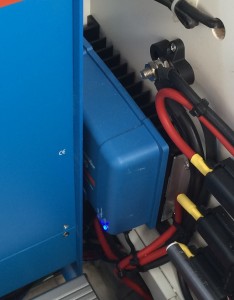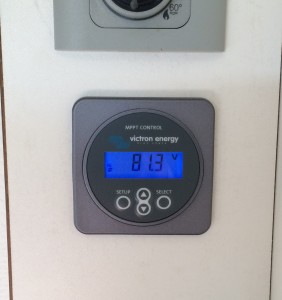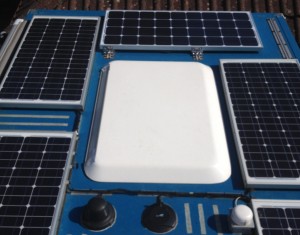Bocklet fitted Cuthbert with four 80 Watt solar panels, a 220 Ah leisure battery and a Pulse Width Modulated (PWM) solar charger. These provide all the power we need in the European summer but to deal with overcast/shadowy conditions we decided to fit an MPPT solar charger controller (Update at April 2018 – click here to see the upgrade to lithium leisure batteries).
In Africa we found that the original system struggled a little for the following reasons:-
- Shorter daylight hours
- Higher temperatures made the solar panels and the leisure battery both less efficient
- Higher temperatures made the fridge use more power
- Sometimes we had to park in areas where the solar panels were in partial shading
To address some of these issues, we have decided to upgrade the solar system and increase its performance. The changes are:
- replacing the Pulse Width Modulated (PWM) solar charger with a Victron Maximum Power Point Tracking (MPPT) solar charger; and changing the wiring of the solar panels from a ‘parallel’ configuration into a ‘series’ configuration. This will make the solar panels more efficient in shady areas, on overcast days and at higher temperatures.
- installing a 5th 80 Watt solar panel which is removable. Now when we park up in a nice shady camp spot, we can easily remove this 5th panel and place it in direct sun light to charge our leisure battery.
- installing a Victron MPPT solar charger controller so that we can monitor the performance of the whole solar installation.
Here is the theory of why we changed from a PWM to MPPT solar charger controller:-
Each solar panel has a maximum output of 4.45A at 18V and with the 4 panels wired ‘in parallel’ (per Cuthbert’s original configuration) this supplied a combined output of 17.8A at 18V (320 Watts) to the PWM solar controller.
The PWM works by switching the power from the solar panel on and off to regulate the voltage applied to the battery. The PWM therefore needs the output of the solar panel to be above that of the battery, but not too high. This works fine on sunny days, but when there is shadow on the panels, or on a generally overcast day, the panel’s output voltage can drop below 13V and the battery receives no charge at all. However, with the 4 panels now wired ‘in series’, the maximum combined output is 4.45A at 72V (320 Watts). This gives the same power as before, but the MPPT electronically reduces this high voltage down to what is required to charge the battery (converting the high voltage/low amperage to low voltage/high amperage).
On a sunny day there is little difference in the performance of the PWM and MPPT controllers; but when there is shade or cloudy overcast, the MPPT has an advantage. If we consider a day when the output of the panels has reduced to 3A at 12V: the combined output of the 4 panels ‘in parallel’ would be 12A at 12V (144 Watts) and the 4 panels ‘in series’ would be 3A at 48V (144 Watts). Unfortunately the output of the panels ‘in parallel’ is below the battery voltage; the PWM cannot make any use of this power and the battery is not charged. However, the MPPT can use the 48V from the panels ‘in series’ and the battery does receive a charge.
Two other advantages of the change are:
a) with the panels wired ‘in series’, the current from the panels is less than with the ‘in parallel’ configuration. This reduces the losses from the cabling between the panels and the charge controller, even though the same amount of power is being delivered from the panels; and
b) each solar panel has a by-pass diode installed as standard, so that if its output drops completely (e.g. it is in shade) the power from the other panels can route through the diode in a series configuration. It is worth noting that the solar panels do not have blocking diodes as standard which means that in a parallel configuration, if one of the panels goes into shade it can actually take power from the other panels. This reduces the output of the other panels and heats up the panel which is in shade – not good!
Hey… was this useful? If so, you might like to support our website costs with a donation below. Thanks 😊👍



